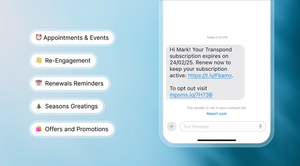Think you need a big budget to make an impact with your small business advertising? Think again. Even on a tight budget, you can get your advertising strategy right and achieve big results with smart, cost-effective methods.
Small business marketing strategy: 8 free methods
#1: Create a free Google My Business account
Creating a free Google My Business account is an essential step for small businesses to improve their online presence.
With this service, you can manage how your business appears on Google Search and Maps – making it easier for potential customers to find you.
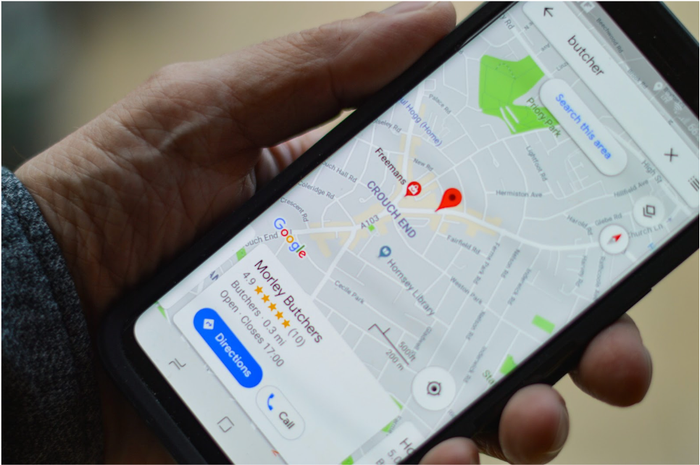
- Go to the Google My Business website and click "Manage Now."
- Sign in with your Google account or create one if you don’t have it.
- Enter your business name, address, and choose a category that fits your business.
- Verify your business by following the instructions Google provides, usually via mail, phone, or email.
With this simple process, you can help improve your profile online and draw more customers. GMB is the most popular business directory, by far. Give it a go and see for yourself. It only takes seconds to create an account and start gathering new leads!
#2: Use local citations
Local citations are mentions of your business name, address, and phone number on various websites and online directories.
Acting sort of like a digital business card, they play a crucial role in local SEO, where they help your business appear more prominently in local search results.

Here's a quick guide to local citations:
- Start by searching for local business directories and websites that list businesses in your area. Examples include the aforementioned GMB, but also Yelp, Yellow Pages, and industry-specific directories. If you have an internet-based product, you can also try Crunchbase, G2, Capterra, or Software Advice.
- Your business information has to be accurate and consistent across all directories. Be sure to include your business name, address, phone number, pictures, social media links, and website. Consistency is key to improving your local search rankings.
- Visit each directory and follow their process for submitting or claiming your business listing. You simply need to create an account, fill out a form with your business details, and wait for approval.
- Check your listings regularly to confirm they remain accurate. Update them if your business information changes, such as a new address or phone number.
Local citations help search engines verify your business's existence and legitimacy.
The more consistent and widespread your citations are, the more trustworthy your business appears to search engines like Google.
Your business will appear more prominently in local search results by leveraging local citations.
This means that when someone in your area searches for a product or service you offer, your business is more likely to appear. Additionally, accurate citations can drive more traffic to your website and physical location, which leads to increased customer engagement and more high-ticket sales.
Using local citations effectively can significantly enhance your small business's online presence and help in reaching local customers, all without spending a dime. You just need to put in a little effort.
If you're feeling like splashing a little cash, you can invest in software like BrightLocal, which will automatically submit your business to many directories.
#3: Participate in online communities
Getting involved in online communities is a terrific opportunity to connect with your target audience and build your brand.
It’s an effective, no-cost advertising strategy for a small business and can lead to long-term relationships with potential customers.

To start:
- Look for online forums, Facebook groups, discussion boards, and subreddits where your target audience hangs out. For example, if you run a local business selling gardening supplies, join gardening forums and Facebook groups related to gardening.
- When people ask questions or need advice, jump in with helpful answers and tips. For instance, if someone asks about the best plants for a shaded area, provide a detailed answer based on your expertise.
- Don’t be shy about sharing your knowledge. When it’s relevant, link back to your website or blog. If you have a detailed guide or a useful article, share it with the community. Just make sure it’s genuinely helpful and not merely self-promotion.
- Engage regularly and contribute to discussions. Don’t just promote your business; be a real part of the community. For example, if you're in a Facebook group for small business owners, participate in discussions about marketing strategies, share your experiences, and offer advice.
Being active in online communities helps you connect directly with your target audience.
You build trust and credibility, both of which are indispensable for small businesses. In fact, trust is the main edge SMBs have over large enterprises.
78% of consumers trust small businesses more than corporations. Engaging with your target audience helps you understand their needs and preferences better, which allows you to tailor your online marketing strategies accordingly. Also, the links back to your website can drive warm referral traffic to your business online.
#4: Ask for reviews
Getting reviews from your customers is a key part of advertising for a small business. Reviews build trust and help find new potential customers.

Here's how to get it right:
- After a target customer makes a purchase or uses your service, simply ask them to leave a review. You can do this in person, through email, using website popups, or via your social media accounts.
- Give clear instructions and direct links to your review pages on platforms like Google, Yelp, Facebook, TripAdvisor, and Trustpilot. Include these links in your emails, on your website, and even on receipts or digital business cards.
- Give customers a small incentive, like a 5-10% discount on their next purchase, to encourage them to leave a review. Make sure this fits within your marketing budget.
- Add a "Leave a Review" button on your website and post reminders on your social media platforms.
- Send a thank-you message to customers who leave reviews to show your appreciation and encourage them to return.
For small businesses, review sites can be great marketing tools.
They help people in your area learn more about your brand and lift your search engine rankings, which makes it easier for new customers to find you. Good reviews act as endorsements, helping you attract more customers and build trust.
Positive feedback makes your business more appealing. In fact, almost all customers look at online reviews before making a purchase.
Positive reviews make potential customers more likely to choose your business, and sharing these reviews on your website and other sales channels boosts your marketing efforts. Also, great reviews give you a competitive edge over other local businesses.
Requesting reviews helps you improve your marketing initiatives and online presence. Even such a basic strategy helps you increase your company's reputation and draw more potential clients.
#5: Attend local events
Attending local events is a valuable marketing strategy that can lead to new customers and partnerships.

There isn't that much to attending local events besides your ability to network. You need to be talkative and easy-going – this will draw potential business your way. Here's how to go about it:
- Look for local events that match your business category and where your target audience is likely to be. Check search engines, each local newspaper, community boards, social media accounts, and websites for event listings.
- Bring business cards, brochures, and any promotional items that showcase your business. Make sure you have a clear, concise message about what your business offers.
- Don’t just stand behind a booth. Walk around, introduce yourself, and start conversations. Be genuinely interested in what others are saying and how you can help them.
- Use these events to build relationships with other local businesses. You're more likely to secure a cross-promotional deal or a business-to-business opportunity at such events.
- Let your followers know you’ll be attending through social media, email marketing tools, your website, or a press release. You will draw more people to your booth or presentation.
- After the event, follow up with the contacts you made. Send a thank you email or connect on social media to keep the relationship going.
Attending local events helps small business owners connect directly with their target audience, local charities, and the community.
Simply showing up and engaging can raise brand awareness without spending a lot of your advertising budget on paid ads or PPC advertising.
You show your commitment to the community and build a stronger, more personal connection with potential customers.
When you go to local events, you gain brand visibility and acquire new customers.
Networking allows you to engage directly with your audience, which helps build trust and credibility. You can also pick up new marketing ideas by observing what other businesses are doing.
Networking with other local businesses can lead to valuable partnerships and cross-promotional deals.
#6: Run a giveaway
Running a giveaway is a fun and easy strategy to engage your audience and garner new followers.
It’s a simple marketing technique that can get you in front of more eyeballs without breaking the bank.
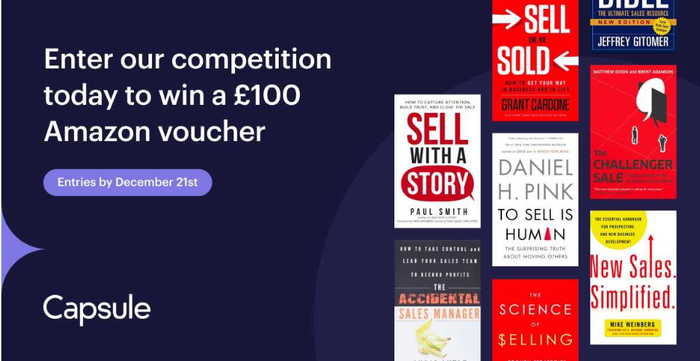
Here's how:
- Choose something that your target audience will love. It could be a popular product, a gift card, or a special service you offer. For example, if you own a local bakery, offer a free cake or a gift card.
- Make it simple for people to enter. Ask them to follow your account, like the post, and tag a couple of friends. For instance, "Follow us, like this post, and tag two friends to enter!"
- Promote your giveaway everywhere – on social media, via email, and on your website. You can even reach out to local news stations or media outlets to get more buzz.
- Reply to comments, thank people for entering, and keep the excitement going. You can build a stronger connection with your audience this way.
- Once the giveaway ends, announce the winner publicly. It adds transparency and generates more excitement for future giveaways.
- After the giveaway, thank everyone for participating and maybe offer a small discount in appreciation. The result? You have a go at turning contenders (and their friends!) into paying customers.
Giveaways are perfect for increasing brand awareness and amplifying your online presence.
They get people talking about your brand and can attract a lot of attention quickly. Offering something valuable shows your followers you appreciate them and draws in new possible clients.
You’ll also get more visibility and bring in new followers.
Giveaways create a buzz around your brand and encourage people to engage with your social media. As participants share your posts, you’ll reach a wider audience, which will drive more traffic to your website and, effectively, secure more customers.
In short, running a giveaway is a cost-effective solution to engage your audience and grow your customer base. Give it a try!
#7 Use a free CRM
If you’re looking for a tool to streamline your customer interactions without spending any money, a free CRM is the way to go. It helps you manage the entire customer journey—from the first hello to a completed sale, and even beyond.
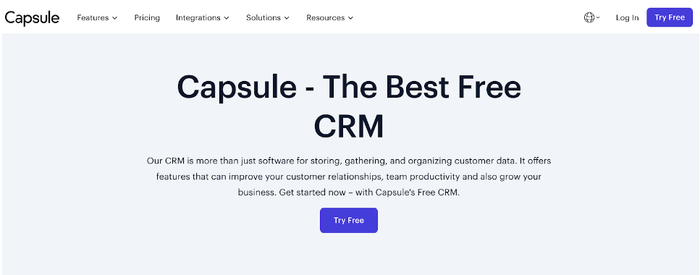
- To get started, you’ll need to choose a CRM that fits your needs. Capsule CRM is a fantastic option for small businesses. It’s free, easy to use, and offers all the features you need to keep track of your customers and sales pipeline. Create a free account now.
- Once you’ve chosen Capsule CRM, setting it up is a breeze. Import your existing customer data – like contact details, previous interactions, and any notes you’ve made. Capsule CRM organizes everything neatly, so you always know where to find what you need.
- With Capsule small business CRM, you can easily segment your contacts based on where they are in the customer journey. You can create groups like leads, active customers, and repeat buyers. Then you can tailor your communication to each group and keep track of everyone's progress.
- One of the best parts of using Capsule CRM is that it lets you automate follow-ups. Automation saves you time and guarantees no one slips through the cracks.
- Capsule CRM records every interaction you have with a customer—whether it’s a phone call, email, or meeting. This means you always have the full picture when you contact someone again.
- Capsule CRM also offers handy reporting features. You can analyze your sales data and customer interactions to see what’s working and where you can improve. Armed with these insights, you will be able to make smarter decisions that lead to more sales.
Capsule CRM is a powerful tool for keeping your customer data organized and at your fingertips.
You’ll have a clear view of every stage of the customer journey so you can provide the right information when and where it’s needed.
Over time, this helps you build stronger relationships with your customers, which leads to increased loyalty and repeat business – all without costing you a penny.
Register now for a free-forever CRM from Capsule!
And if you’d like to upgrade, you can do it whenever you want!
#8 Make the most of video format
Short-form videos have become a game-changer for small businesses. With 39% of marketers reporting higher ROI on videos between 30-60 seconds, it’s clear that this format drives results. Using short videos can increase brand awareness and attract customers while reducing advertising costs. While traditional marketing methods often struggle with engagement, video content, including short-form videos, can increase conversion rates by up to 86%.
Short videos are perfect for improving your marketing efforts on various marketing channels, supporting a successful marketing plan, and connecting with your community.
You can post different types of video content, such as:
- Behind-the-scenes tours. Show your workspace, team in action, or how your products are made to build authenticity. You can, for example, create a series that covers different aspects of your business, from product development to daily operations.
- Customer testimonials. Share short clips of satisfied customers to help raise brand awareness about your business. You don’t need to create and publish all testimonials at once, but gradually building a library of real experiences helps reinforce credibility.
- How-to/tutorial videos. Offer quick guides that provide value and address common questions. Sassy Saints, for example, creates videos showing how to apply their products properly or prepare for their application. These short, informative clips help customers feel more confident using the product:

Source: https://www.instagram.com/p/DGi8jOhNlZw/
- Quick tips. Create videos that share practical tips related to your niche, positioning your brand as an expert. For example, a consulting business specializing in small business growth could post videos like "3 quick ways to improve cash flow" or "How to price your services for maximum profit."
Small business advertising: 7 cost-effective methods
Why spend a fortune on advertising when you can achieve great results with a smaller budget? There are many smart, cost-effective ideas to get your small business noticed and bring in more customers without overspending.
#1 Use Google Ads
Investing in Google Ads can be a highly cost-effective avenue for small businesses to reach a targeted audience and drive traffic to their websites. Contrary to popular belief, you don't need to spend a little fortune on your ads!

Here's how to get started:
- Go to the Google Ads website and click "Start Now."
- Sign in with your Google account – or create one if you don't have it.
- Google Adwords allows you to set a daily budget that you are comfortable with. Start with a small amount, like $5 to $10 per day. You can always increase it based on the performance of your ads.
- Use Google’s Keyword Planner to find relevant keywords for your business. Focus on specific, localized keywords to reach local customers, such as “best pizza in [Your Town].” You can also use tools like Answer the Public to expand your research.
- Write compelling ad copy that highlights the unique selling points of your business. Include a clear call-to-action (CTA) like “Visit our store today” or “Order online now".
- Design simple, engaging ads with high-quality images if you’re using display ads. You can use free tools like Canva or Visme.
- Use Google’s targeting options to reach specific demographics, locations, and interests. For example, if you run a local bakery, target people in your town who have shown interest in baking or food.
- Don't follow the "set and forget" approach! Regularly review the performance of your ads using Google Ads’ analytics tools. Track metrics like clicks, impressions, and conversions.
- Adjust your keywords, ad copy, and budget based on what works best to improve your ROI (return on investment)
Google Ads is splendid for small business marketing because it gets your message in front of people actively searching for your offer. It makes every advertising dollar count by targeting the right audience.
The ROI can be impressive. Many businesses see a return of $2 for every $1 spent on Google Ads. This is because you’re reaching people ready to buy, and you can track and tweak your ads in real time to get the best results.
#2 Use social media platforms
Nowadays, using social media platforms is a must for any small business looking to expand its reach and engage with customers. It’s a versatile marketing strategy that can be both cost-effective and highly impactful.

Now for some social media tips:
- Post regularly on your social media channels with content that resonates with your audience. Share behind-the-scenes looks, video ads, customer testimonials, product highlights, and even fun, relatable memes.
- Don’t just post – interact! Reply to comments, like and comment on user posts, and engage in conversations. For instance, if someone tags your business in a post, thank them and start a conversation. You will build a sense of community and loyalty.
- Use relevant hashtags to increase your content’s reach. Tag local businesses or influencers to reach a wider audience. For example, if you own a bakery, use hashtags like #LocalBakery, #FreshBread, and tag local food bloggers whenever it makes sense.
- Invest in digital ads on platforms like Facebook, LinkedIn, and Instagram ads. More often than not, these platforms allow you to target specific demographics, interests, and behaviors. Create ad campaigns that highlight promotions, pricing changes, new products, or special events.
- Partner with social media influencers and other businesses that align with your brand. They can help promote your products to a broader audience. For example, if you sell handmade jewelry, collaborate with a fashion influencer who can showcase your pieces to their followers.
- Use the analytics tools provided by social media platforms to track the performance of your posts and ad campaigns. Look at metrics like engagement, reach, and conversions. Adjust your strategy based on what works best.
Social media is a game-changer for connecting with your target audience.
You can reach tons of people quickly and tailor your approach to fit any budget. Through social media, you can interact with customers directly and organically, whether you run paid ads or organic engagement.
Using social media channels advances your brand awareness and helps captivate new customers.
Engaging with your audience builds loyalty and trust, which are crucial for any small business. Running ad campaigns allows you to target specific groups so that you can be sure your message hits the right people. Social media drives website traffic and strengthens your online presence.
In short, social media is a dynamic, interactive medium to connect with your audience and grow your business. Since ¾ of businesses are already using social media, you definitely shouldn’t skip it.
#3 Explore apps like Product Hunt/AppSumo
Getting into platforms like Product Hunt and AppSumo can be a turning point for businesses looking to launch and promote their products. These platforms are designed to help you reach a wider audience, gain traction, and increase sales.

Here's a quick rundown on Product Hunt usage:
- Start by creating a strong profile on Product Hunt. Your profile should clearly represent your brand, with a compelling bio and a link to your website/socials. Engage with the community by upvoting and commenting on other products to build your presence.
- Before launching, make sure your product is polished and ready to impress. Create high-quality visuals, a clear product description, and a catchy tagline. Your goal is to capture attention quickly and retain it as long as possible.
- Launch your product by submitting it to Product Hunt. Timing matters here – launches are most successful when they happen early in the day, especially during weekdays. Be prepared to respond to comments and questions as they come in.
- During and after your launch, engage actively with the Product Hunt community. Respond to feedback, thank people for their support, and keep the conversation going. That way, you build momentum and keep your product visible.
- Ask your existing users, email list members, social media groups, and network to support your launch by upvoting, commenting, and sharing your product on their social media channels. The more buzz you create, the better your product will perform.
And here's another overview, this time for AppSumo:
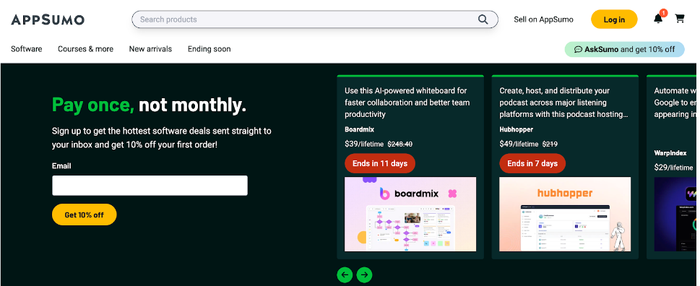
- AppSumo focuses on offering exclusive deals on software products. To get started, you need to create a compelling deal that offers real value to users. AppSumo is mostly known for its lifetime deals, so this would be your best bet.
- Submit your product to AppSumo so that you can highlight the benefits and features that make it stand out. AppSumo's team will review your submission to see if it’s a good fit for their audience.
- AppSumo users are known for giving honest, detailed feedback. Be ready to engage with them, answer questions, and make improvements based on their input. This can lead to better user satisfaction and more sales.
- AppSumo does a lot of the heavy lifting by promoting your product through their platform. However, you should also promote your deal through your own channels. Use email marketing, social media, and press releases to spread the word.
- Positive reviews on AppSumo can build your credibility and increase sales. Encourage satisfied customers to leave reviews and use their feedback to refine your product.
Note: We advise caution when using AppSumo. Turning your product from a monthly plan-based pricing to a one-time license is a radical step. It does bring in quick buck, but long-term, it may be unviable. Through this step, you cut a lot of your monthly revenue. Your customer lifetime value falls substantially, too. It may not bring in the income needed to sustain your business. |
Product Hunt stands out as a platform for generating buzz and driving early adoption. It’s ideal for launching new products and getting feedback from a tech-savvy audience. A successful launch on Product Hunt can significantly increase your ROI.
AppSumo, on the other hand, is perfect for businesses looking to raise sales quickly by offering exclusive deals. It’s an excellent opportunity to tap into a community of deal-seekers who are eager to try new software and tools. On top of that, the feedback you receive can be invaluable for improving your product.
Both of these platforms offer unique opportunities that you can't really find anywhere else. If you have an up-and-coming tech product, be sure to give it a whirl.
#4: Start a blog
Enhancing your online presence can be as easy as adding a blog to your existing website.
While it requires a bit of time and effort, the benefits for your business can be substantial.
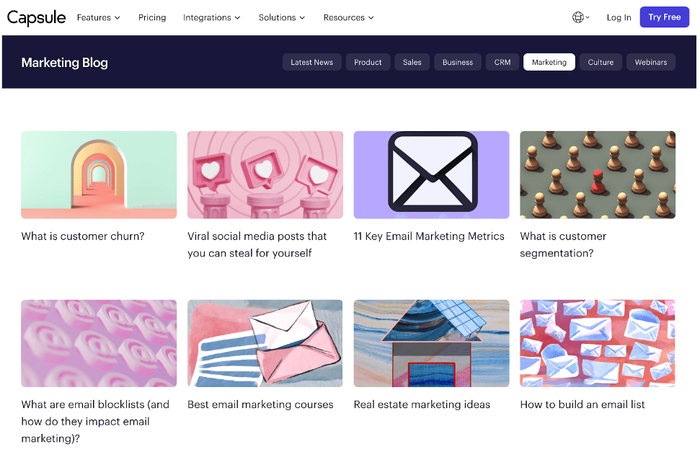
Many businesses, especially e-commerce websites, miss out on SERP real estate and customer engagement simply because they don’t have a blog.
To go about it:
- If your website doesn’t have a blog yet, integrating one is easier than you might think. Most website platforms, like WordPress or Shopify, offer built-in blogging features. Simply add a “Blog” section to your site, and you’re ready to start publishing.
- Start by writing about topics that matter to your customers. Think about the questions they ask, the problems they face, and how your products or services provide solutions. For example, if you run an e-commerce site selling eco-friendly products, you could write about “How to Live a Zero-Waste Lifestyle” or “Top Benefits of Using Sustainable Materials.”
- When creating blog content, focus on long-tail keywords with purchasing intent. These are specific search terms that potential customers might use when they’re close to making a purchase. For instance, instead of just writing about “eco-friendly products,” you might target “best eco-friendly cleaning products for kitchens.”
- Use your blog to guide readers towards your products. Within your posts, include internal links to your product pages where relevant. For example, if you’re writing about sustainable living, link to your eco-friendly product lines. If the content is well done, it can convert surprisingly well.
- Your blog should serve as a resource for your customers. Write posts that educate your audience about your industry, explain the benefits of your products, and offer tips and solutions. Engaging content keeps visitors on your site longer and encourages them to explore your offerings.
Adding a blog to your website helps you engage with your audience and provide valuable information. You get to showcase your expertise and build trust with potential customers. More importantly, it helps search engines find and rank your site.
#5: Launch an email newsletter
Email newsletters are known to be highly effective and cost-efficient for staying connected with your customers and keeping them engaged with your business.

You can start your email newsletter by following the below steps:
- Start by gathering email addresses from your existing customers and website visitors. In exchange for signing up, you can offer an incentive, like a discount or a free resource. Make sure to have a sign-up form on your website, social media channels, and even at your physical location if you have one.
- Pick an email marketing tool that suits your needs. Platforms like Mailchimp, Constant Contact, or Sendinblue offer easy-to-use templates, list management, and tracking features. These tools often have free plans or affordable options for small businesses. However, we recommend Transpond! It has all the features you need and more.
- Not all customers are the same, so segment your email list based on different criteria, like purchase history, location, or interests. You can then send more targeted, relevant content to each group.
- Plan the content for your newsletter. Include updates about your business, upcoming promotions, tips related to your industry, and links to your blog or social media. Keep the content valuable and interesting so that subscribers look forward to receiving your emails.
- Use your email marketing platform’s templates to design a clean, visually appealing newsletter. Incorporate your branding, like your logo and color scheme, to make it instantly recognizable. Make sure it’s mobile-friendly since many people check emails on their phones.
- The subject line is the first thing recipients see, so make it catchy and relevant to encourage them to open the email. For example, “Get Ready for Our Big Sale!” or “Top Tips for a Greener Home.”
- Decide on the frequency of your newsletter—weekly, bi-weekly, or monthly, depending on your content and audience. Schedule your emails to go out at a time when your audience is most likely to engage, typically mid-morning or early afternoon during the week.
- After sending your newsletter, monitor its performance using your email platform’s analytics tools. Look at open rates, unsubscribe rates, click-through rates, and conversions. Use this data to tweak your future newsletters for better results.
An email newsletter is one of the most cost-effective advertising methods available. It allows you to maintain regular communication with your customers and keep your brand top of mind.
Over time, a well-executed newsletter can lead to increased customer loyalty and, ultimately, higher sales—all while staying within a modest budget.
#6: Start a referral program
Through referral programs, you can reach new customers by leveraging your existing ones.
When you encourage satisfied customers to refer friends and family, you can expand your customer base with little or no money.

To launch a referral program, follow these steps:
- Define the things you will offer. It should be something valuable to both the referrer and the new customer. It could be a discount, a free product, a membership, or a special service. It has to align with your small business marketing strategy and appeal to your target audience.
- Use your social media accounts, email newsletters, blogs, and in-store signage to inform your customers about the referral program. Also, share the details on your Google Business Profile and other local listings.
- Provide simple referral methods. One option is to share a unique referral link through social media apps or hand out referral cards during business hours.
- Use digital tools like ReferralRock to track referrals and rewards. They will help manage the program efficiently and check that all referrals are recognized and rewarded.
- Show appreciation to customers who make referrals. A thank you email or a small bonus reward can build customer loyalty and encourage more referrals.
Referral programs are an effective small business marketing strategy because they build trust through word-of-mouth recommendations.
Prospective customers are more likely to trust referrals from friends and family, which can lead to higher conversion rates than other advertising strategies.
Implementing a referral program is a smart move because it helps you obtain new customers without spending much on advertising. A referral program also strengthens your brand awareness in the local community and drives more targeted traffic to your business page and website.
When your happy customers recommend you, it increases customer loyalty and brings in more paying customers.
Referral programs fit well with your other marketing campaigns and local initiatives. You can cross-promote through social media platforms, email marketing, or direct mail. A well-planned referral program can be a powerful addition to your marketing strategies.
#7 Partner with other small business owners
Teaming up with another small business owner is a marvelous technique to augment your marketing strategy.
Working together will help you reach more people and enable your marketing initiatives to go further.

- Look for local businesses that complement what you do. For example, if you run a bakery, partnering with a local coffee shop could be perfect. Check out professional groups, local events, and social media to find other business owners that fit well with yours.
- Contact the small business owner and propose working together. Be clear about how both of you can benefit. You could promote each other on social media, through email marketing, or on your website.
- Work together to come up with marketing strategies. This could be hosting a combined event, exchanging backlinks, offering special deals, or running a joint ad campaign.
- Take advantage of each business's strengths. If your partner excels at social media, let them handle that while you focus on other things, like search engine optimization or creating content for your website.
- Monitor your partnership's progress. Examine website traffic, social media interactions, and customer feedback to determine what's working and what needs tweaking. Communicate regularly with your partner for smooth operation.
Working with other businesses helps you reach more people and maximize your advertising dollars. You can share resources and ideas, which can strengthen your marketing strategies. Also, it helps grow brand awareness in your local area and build a strong online presence.
Joining forces with other small businesses can bring in great numbers of new customers.
It makes your marketing campaigns more effective and helps you save on advertising costs. Joint efforts like cross-promotional deals and combined ad campaigns can drive more traffic to your website. And, these partnerships can lead to long-lasting relationships that benefit your business in the long run.
Conclusion
Getting your small business noticed doesn’t have to break the bank. By using these cost-effective advertising methods, you can:
- build your brand,
- attract customers,
- grow your business without overspending.
To keep track of all your customer interactions and maximize your efforts, consider using a free CRM like Capsule. It’s an easy way to stay organized and guarantee you’re making the most of every opportunity.



